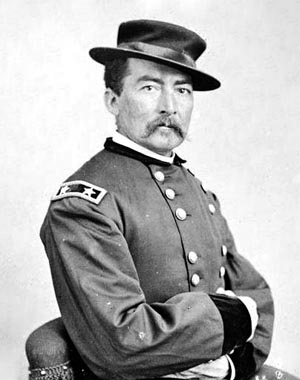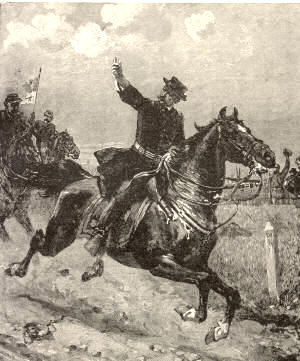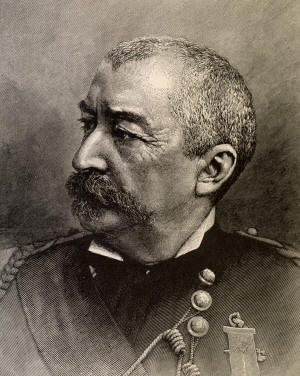|
This Site:
Civil War
Harper's Weekly
Civil War Battles
Confederate Generals
Union Generals
Indians
Indian Tribes
Indian Territory
Custer's Last Stand
Republic of Texas
Westward Expansion
Mexican War
Slavery
Civil War Medicine
American Revolution
Winslow Homer
Thomas Nast
Mathew Brady
Western Art |
|
Up |
General Sheridan in the Civil War
| The
Poem, "Sheridan's Ride" |
|
Sheridan, PHILIP
HENRY, military officer; born in Albany, N. Y., March 6,
1831; graduated at West Point in 1853; served with much credit in
Texas
and Oregon, doing good service in the latter region, and settling
difficulties with the Indians; was made captain in May, 1861, and during
the summer was president of a military commission to audit claims in
Missouri. In December he was made chief commissary of the Army of the
Southwest, and was on the staff of General Halleck at Corinth performing
the same duties. In May, 1862, he was made colonel of the 2nd Michigan
Cavalry; on June 6 defeated Forrest's cavalry, and on July 1 repulsed
and defeated a superior Confederate force under Chalmers at Booneville,
Miss. He was then at the head of a brigade of cavalry, and was made
brigadier-general. In August he defeated Faulkner's cavalry in
Mississippi. |

General Phil Sheridan
|
|
Late in September he took
command of a division in the Army of the Ohio, and led another division
at the battle of Perryville. He also commanded a division with great
efficiency in the battle at Stone River, and for his services there he
was made (Dec. 31) major-general of volunteers. He afterwards rendered
signal service in the battles of Chickamauga and Missionary Ridge, when
he was transferred to the Army of the Potomac (April, 1864) as chief of
cavalry. When the Federal army emerged
from the Wilderness, in 1864, General Sheridan was sent to cut Lee's
communications with Richmond. This was the first of the great raids of
that leader in Virginia, and was a short but destructive one. He took
with him a greater portion of the cavalry led by Merritt, Gregg, and
Wilson, crossed the North Anna on May 9, and struck the Virginia Central
Railroad, capturing Beaver Dam Station. He destroyed 10 miles of the
railway, its rolling stock, 1,500,000 rations, and released 400 Union
prisoners on their way to Richmond. There he was attacked by Stuart and
his cavalry, but was not much impeded thereby. He pushed forward, and on
the morning of the 11th captured Ashland Station, on the Fredericksburg
road, a few miles from Richmond, where he destroyed the railroad for 6
miles and a large quantity of stores. He was charged with menacing
Richmond and communicating with the Army of the James, under General
Butler. A few miles from Richmond he had another sharp contest with
Stuart, and drove him and his cavalry towards Ashland. Stuart was
killed, and General Gordon was mortally wounded. Sheridan still pressed
on, and made a dash upon the outer works at Richmond. Custer's brigade
carried them at that point and made 100 prisoners. The inner works were
too strong for cavalry. The Confederates gathered, and in a fight
Sheridan was repulsed. He led his command across the Chickahominy,
fighting a Confederate force at Meadow Bridge; destroyed a railway
bridge; rested three days at Haxhall's Landing, on theJames, and
procured supplies; and then, by way of the White House, leisurely
returned to the Army of the Potomac. |
|

General Phil Sheridan Famous Ride |
In the campaign against Richmond until
August, 1864, he did signal service in making destructive raids on Lee's
communications. On Aug. 1 he was detached to the valley of the
Shenandoah, where he defeated the Confederates in several engagements.
During this campaign General Wright was defeated by General Early on
Oct. 18, 1864, at CEDAR CREEK (q. v.). Sheridan at the time was in
Winchester, and as soon as he got the news he rode to the front at a
swinging gallop, rallied the Nationals, and crushed Early.
Sheridan's ride has been immortalized in poetry, art, and song.
|
|
Sheridan left Winchester on Feb. 27,
1865, with about 10,000 men, composed of the divisions of cavalry of
Merritt and
George Custer. To the latter division was added a brigade of West
Virginia troops under Colonel Capehart. Sheridan's troops moved rapidly
up the Shenandoah Valley towards Staunton. On the way they met Rosser,
with 400 men, who was disposed to dispute the passage of a fork of the
Shenandoah; but he was soon chased away, and the column moved on to
Staunton and Rockfish Gap. Early, with 2,500 men behind strong
intrenchments, was at Waynesboro to dispute their passage. Custer soon
routed him, capturing 1,600 of his men, with eleven guns, seventeen
battle-flags, and 200 loaded wagons, with a loss of less than a
dozen men. This finished Early as a military leader. The raiders
destroyed Confederate property in the vicinity valued at $1,000,000.
During that night Sheridan went over |

Philip H. Sheridan |
|
the Blue Ridge in a drenching rain,
and entered Charlottesville late the next day, where he waited for his
pontoons and ammunition to come over the mountains. In the mean time his
troops destroyed bridges, factories, depots, and the railway in the
direction of Lynchburg for about 8 miles. Satisfied that the latter
place was too strong for him, he divided his force and pushed for the
James River. Rains had so swollen the river that his pontoons would not
span it. Proceeding eastward, he destroyed the James River Canal (then
the chief channel of supplies for Richmond) and numerous bridges. This
produced the greatest consternation in Richmond. The Confederate
government prepared to fly, and the families of officials packed for a
journey. The Congress, made nervous, wanted to adjourn and depart, but
they were persuaded to remain. From Columbia, where Sheridan rested a
day, he dashed off to the Virginia Central Railway, which he destroyed
for the distance of 15 miles. Then Custer in one direction, and Devin in
another, made complete destruction of railways and bridges, as well as
supplies, in Lee's rear, inflicting a more serious blow to the
Confederate cause than any victory during the last campaign. Sheridan
then swept around by the White House, and joined the army before
Petersburg on March 26. He had disabled fully 200 miles of railway,
destroyed a vast number of bridges, and property to the value of several
million dollars.
After the war he was in command in
Louisiana and Texas, and enforced the "reconstruction" acts there, for
which he was removed by President Johnson in August, 1867. He was made
lieutenant-general in March, 1869, and general of the army, June 1,
1888. He died in Nonquitt, Mass., Aug. 5, 1888. |
|


